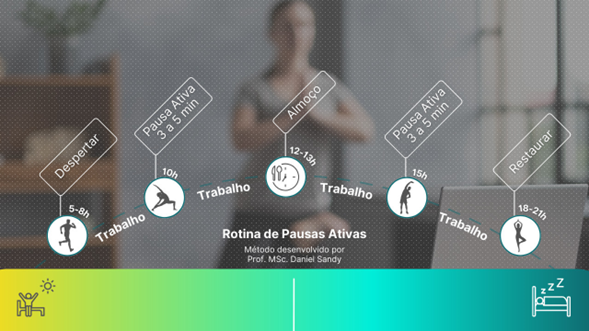El impacto de las pausas activas en el lugar de trabajo en la percepción del estrés, el dolor y la calidad del sueño en trabajadores administrativos
DOI:
https://doi.org/10.61661/BJLM.2023.v2.76Palabras clave:
estrés laboral, dolor de la región lumbar, comportamiento sedentário, pausas activas, estrés, sueño, trabajadores de oficinaResumen
Introducción: El sedentarismo conductual es considerado un grave problema de salud pública a nivel mundial. El estrés, el dolor lumbar y la mala calidad del sueño se encuentran entre las mayores causas de presentismo y ausentismo en el lugar de trabajo y una mejor gestión del estilo de vida sedentario durante la jornada laboral puede ser un promotor de la salud y la productividad de los trabajadores. Objetivo: Investigar el impacto de introducir una rutina de pausas activas en la actividad física diaria, sobre la autopercepción del estrés, la lumbalgia y la calidad del sueño en trabajadores administrativos. Método: Estudio descriptivo-exploratorio realizado con 114 profesionales administrativos de ambos sexos (76% mujeres). Se indicó a los participantes que siguieran una rutina de descanso activo durante 12 semanas con el apoyo de una aplicación (APP) y se utilizó un cuestionario previo y posterior a la intervención. Resultados/Discusión: Antes de la intervención, el 75,4% de los trabajadores no realizaban descansos activos. Luego de la intervención, el 39,5% de los trabajadores comenzó a tomar al menos 1 descanso activo diario y el 44% comenzó a tomar 2 o más descansos activos por día (p=0,01). Se observó una reducción significativa en la percepción del estrés (p=0,004) y del dolor lumbar durante el viaje (p<0,001), con un 32% de los participantes afirmando no sentir más dolor después de la intervención. Además, observamos una mejora en la calidad del sueño (p=0,001) y un aumento significativo en la frecuencia de ejercicio semanal en el grupo (p<0,0001). Los resultados indican una asociación positiva entre el manejo del comportamiento sedentario en el lugar de trabajo y la percepción de signos relacionados con el estrés físico y mental. Conclusión: La rutina de pausas activas en el lugar de trabajo parece tener un impacto positivo en el sedentarismo, reduciendo la percepción de dolor, estrés y calidad del sueño en trabajadores administrativos, y puede ser parte de pautas ergonómicas para empleadores y organismos reguladores. La incorporación de esta rutina puede resultar en que los empleados sean más activos y menos reactivos al estrés físico y psicofisiológico relacionado con el trabajo, promoviendo así un ambiente de trabajo más saludable y productivo, además de impactar la calidad del sueño y potenciar una mayor actividad física en el lugar de trabajo. periodo de ocio.
Citas
Smirmaul BPC, Chamon RF, Moraes FM, Rozin G, Moreira ASB, Almeida R, Guimarães ST. Lifestyle medicine during (and after) the covid-19 pandemic. Am J Lifestyle Med. 2020;15(1):60-7. https://doi.org/10.1177/1559827620950276 - PMID:33456421 PMCID:PMC7781056 DOI: https://doi.org/10.1177/1559827620950276
Phillips EM, Frates EP, Park DJ. Lifestyle medicine. Phys Med Rehabil Clin N Am. 2020;31(4):515-26. https://doi.org/10.1016/j.pmr.2020.07.006 PMID:32981575 DOI: https://doi.org/10.1016/j.pmr.2020.07.006
Kreouzi M, Theodorakis N, Constantinou C. Lessons learned from blue zones, lifestyle medicine pillars and beyond: an update on the contributions of behavior and genetics to wellbeing and longevity. Am J Lifestyle Med. Forthcoming 2022. https://doi.org/10.1177/15598276221118494 DOI: https://doi.org/10.1177/15598276221118494
Bull FC, Al-Ansari SS, Biddle S, Borodulin K, Buman MP, Cardon G, Carty C, Chaput JP, Chastin S, Chou R, Dempsey PC, DiPietro L, Ekelund U, Firth J, Friedenreich CM, Garcia L, Gichu M, Jago R, Katzmarzyk PT, Lambert E, Leitzmann M, Milton K, Ortega FB, Ranasinghe C, Stamatakis E, Tiedemann A, Troiano RP, van der Ploeg HP, Wari V, Willumsen JF. World Health Organization 2020 guidelines on physical activity and sedentary behaviour. Br J Sports Med. 2020;54(24):1451-62. https://doi.org/10.1136/bjsports-2020-102955 PMID:33239350 - PMCID:PMC7719906 DOI: https://doi.org/10.1136/bjsports-2020-102955
Blasche G, Szabo B, Wagner-Menghin M, Ekmekcioglu C, Gollner E. Comparison of rest-break interventions during a mentally demanding task. Stress Health. 2018;34(5):629-38. https://doi.org/10.1002/smi.2830 - PMID:30113771 PMCID:PMC6585675 DOI: https://doi.org/10.1002/smi.2830
Huang R, Ning J, Chuter VH, Taylor JB, Christophe D, Meng Z, Xu Y, Jiang L. Exercise alone and exercise combined with education both prevent episodes of low back pain and related absenteeism: systematic review and network meta-analysis of randomised controlled trials (RCTs) aimed at preventing back pain. Br J Sports Med. 2020;54(13):766-70. https://doi.org/10.1136/bjsports-2018-100035 PMID:31672696 DOI: https://doi.org/10.1136/bjsports-2018-100035
Ozemek C, Arena R. Evidence supporting moving more and sitting less. Prog Cardiovasc Dis. 2021;64:3-8. https://doi.org/10.1016/j.pcad.2020.12.004 PMID:33373619 DOI: https://doi.org/10.1016/j.pcad.2020.12.004
Dunstan DW, Dogra S, Carter SE, Owen N. Sit less and move more for cardiovascular health: emerging insights and opportunities. Nat Rev Cardiol. 2021;18(9):637-48. https://doi.org/10.1038/s41569-021-00547-y PMID:34017139 DOI: https://doi.org/10.1038/s41569-021-00547-y
Bailey DP. Sedentary behaviour in the workplace: prevalence, health implications and interventions. Br Med Bull. 2021;137(1):42-50. https://doi.org/10.1093/bmb/ldaa039 PMID:33710270 DOI: https://doi.org/10.1093/bmb/ldaa039
Woessner MN, Tacey A, Levinger-Limor A, Parker AG, Levinger P, Levinger I. The evolution of technology and physical inactivity: the good, the bad, and the way forward. Front Public Health. 2021;9:655491. https://doi.org/10.3389/fpubh.2021.655491 PMID:34123989 - PMCID:PMC8193221 DOI: https://doi.org/10.3389/fpubh.2021.655491
Pinto AJ, Bergouignan A, Dempsey PC, Roschel H, Owen N, Gualano B, Dunstan DW. Physiology of sedentary behavior. Physiol Rev. 2023;103(4):2561-622. https://doi.org/10.1152/physrev.00022.2022 PMID:37326297 DOI: https://doi.org/10.1152/physrev.00022.2022
World Health Organization. Global status report on physical activity 2022. Geneva: World Health Organization; 2022. https://www.who.int/publications/i/item/9789240059153
Garcia-Hermoso A, López-Gil JF, Ramírez-Vélez R, Alonso-Martínez AM, Izquierdo M, Ezzatvar Y. Adherence to aerobic and muscle-strengthening activities guidelines: a systematic review and meta-analysis of 3.3 million participants across 32 countries. Br J Sports Med. 2023;57(4):225-9. https://doi.org/10.1136/bjsports-2022-106189 PMID:36418149 DOI: https://doi.org/10.1136/bjsports-2022-106189
Oliveira AB, Katzmarzyk PT, Dantas WS, Benseñor IJM, Goulart AC, Ekelund U. Profile of leisure-time physical activity and sedentary behavior in adults in Brazil: a nationwide survey, 2019. Epidemiol Serv Saude. 2023;32(2):e2023168. https://doi.org/10.1590/s2237-96222023000200016 PMID:37585879 - PMCID:PMC10421589 DOI: https://doi.org/10.1590/s2237-96222023000200016
Pontzer H, Wood BM, Raichlen DA. Hunter-gatherers as models in public health. Obes Rev. 2018;19 Suppl 1:24-35. https://doi.org/10.1111/obr.12785 PMID:30511505 DOI: https://doi.org/10.1111/obr.12785
Lieberman DE, Kistner TM, Richard D, Lee IM, Baggish AL. The active grandparent hypothesis: physical activity and the evolution of extended human healthspans and lifespans. Proc Natl Acad Sci U S A. 2021;118(50):e2107621118. https://doi.org/10.1073/pnas.2107621118 - PMID:34810239 PMCID:PMC8685690 DOI: https://doi.org/10.1073/pnas.2107621118
Raichlen DA, Lieberman DE. The evolution of human step counts and its association with the risk of chronic disease. Curr Biol. 2022;32(21):R1206-14. https://doi.org/10.1016/j.cub.2022.09.030 PMID:36347224 DOI: https://doi.org/10.1016/j.cub.2022.09.030
Presta V, Gobbi G, Condello G, Carubbi C, Masselli E, Mirandola P, Vitale M. Evolution led humans to bipedalism, but we live in a sedentary society: will "Sunday running" protect us from NCDs at no cost? Front Public Health. 2023;10:1031911. https://doi.org/10.3389/fpubh.2022.1031911 - PMID:36684966 PMCID:PMC9853276 DOI: https://doi.org/10.3389/fpubh.2022.1031911
Stults-Kolehmainen MA. Humans have a basic physical and psychological need to move the body: physical activity as a primary drive. Front Psychol. 2023;14:1134049. https://doi.org/10.3389/fpsyg.2023.1134049 - PMID:37113126 PMCID:PMC10128862 DOI: https://doi.org/10.3389/fpsyg.2023.1134049
Kaplan H, Thompson RC, Trumble BC, Wann LS, Allam AH, Beheim B, Frohlich B, Sutherland ML, Sutherland JD, Stieglitz J, Rodriguez DE, Michalik DE, Rowan CJ, Lombardi GP, Bedi R, Garcia AR, Min JK, Narula J, Finch CE, Gurven M, Thomas GS. Coronary atherosclerosis in indigenous South American Tsimane: a cross-sectional cohort study. Lancet. 2017;389(10080):1730-9. https://doi.org/10.1016/s0140-6736(17)30752-3 - PMID:28320601 PMCID:PMC6028773 DOI: https://doi.org/10.1016/S0140-6736(17)30752-3
Raichlen DA, Pontzer H, Zderic TW, Harris JA, Mabulla AZP, Hamilton MT, Wood BM. Sitting, squatting, and the evolutionary biology of human inactivity. Proc Natl Acad Sci U S A. 2020;117(13):7115-21. https://doi.org/10.1073/pnas.1911868117 PMID:32152112 - PMCID:PMC7132251 DOI: https://doi.org/10.1073/pnas.1911868117
Poulain M, Herm A, Errigo A, Chrysohoou C, Legrand R, Passarino G, Stazi MA, Voutekatis KG, Gonos ES, Franceschi C, Pes GM. Specific features of the oldest old from the longevity blue zones in Ikaria and Sardinia. Mech Ageing Dev. 2021;198:111543. https://doi.org/10.1016/j.mad.2021.111543 PMID:34265327 DOI: https://doi.org/10.1016/j.mad.2021.111543
Schultchen D, Reichenberger J, Mittl T, Weh TRM, Smyth JM, Blechert J, Pollatos O. Bidirectional relationship of stress and affect with physical activity and healthy eating. Br J Health Psychol. 2019;24(2):315-33. https://doi.org/10.1111/bjhp.12355 PMID:30672069 - PMCID:PMC6767465 DOI: https://doi.org/10.1111/bjhp.12355
Mikkelsen K, Stojanovska L, Polenakovic M, Bosevski M, Apostolopoulos V. Exercise and mental health. Maturitas. 2017;106:48-56. https://doi.org/10.1016/j.maturitas.2017.09.003 PMID:29150166 DOI: https://doi.org/10.1016/j.maturitas.2017.09.003
MacKinnon GE, Brittain EL. Mobile health technologies in cardiopulmonary disease. Chest. 2020;157(3):654-64. https://doi.org/10.1016/j.chest.2019.10.015 - PMID:31678305 PMCID:PMC7078586 DOI: https://doi.org/10.1016/j.chest.2019.10.015
Scheffer DDL, Latini A. Exercise-induced immune system response: anti-inflammatory status on peripheral and central organs. Biochim Biophys Acta Mol Basis Dis. 2020;1866(10):165823. https://doi.org/10.1016/j.bbadis.2020.165823 - PMID:32360589 PMCID:PMC7188661 DOI: https://doi.org/10.1016/j.bbadis.2020.165823
Dzakpasu FQS, Carver A, Brakenridge CJ, Cicuttini F, Urquhart DM, Owen N, Dunstan DW. Musculoskeletal pain and sedentary behaviour in occupational and non-occupational settings: a systematic review with meta-analysis. Int J Behav Nutr Phys Act. 2021;18:159. https://doi.org/10.1186/s12966-021-01191-y PMID:34895248 - PMCID:PMC8666269 DOI: https://doi.org/10.1186/s12966-021-01191-y
Dempsey PC, Biddle SJH, Buman MP, Chastin S, Ekelund U, Friedenreich CM, Katzmarzyk PT, Leitzmann MF, Stamatakis E, van der Ploeg HP, Willumsen J, Bull F. New global guidelines on sedentary behaviour and health for adults: broadening the behavioural targets. Int J Behav Nutr Phys Act. 2020;17:151. https://doi.org/10.1186/s12966-020-01044-0 - PMID:33239026 PMCID:PMC7691115 DOI: https://doi.org/10.1186/s12966-020-01044-0
Edwardson CL, Yates T, Biddle SJH, Davies MJ, Dunstan DW, Esliger DW, Gray LJ, Jackson B, O'Connell SE, Waheed G, Munir F. Effectiveness of the Stand More AT (SMArT) Work intervention: cluster randomised controlled trial. BMJ. 2018;363:k3870. https://doi.org/10.1136/bmj.k3870 - PMID:30305278 PMCID:PMC6174726 DOI: https://doi.org/10.1136/bmj.k3870
Saint-Maurice PF, Troiano RP, Matthews CE, Kraus WE. Moderate-to-vigorous physical activity and all-cause mortality: do bouts matter? J Am Heart Assoc. 2018;7(6):e007678. https://doi.org/10.1161/jaha.117.007678 - PMID:29567764 PMCID:PMC5907548 DOI: https://doi.org/10.1161/JAHA.117.007678
Giurgiu M, Nissen R, Muller G, Ebner-Priemer UW, Reichert M, Clark B. Drivers of productivity: being physically active increases yet sedentary bouts and lack of sleep decrease work ability. Scand J Med Sci Sports. 2021;31(10):1921-31. https://doi.org/10.1111/sms.14005 PMID:34170563 DOI: https://doi.org/10.1111/sms.14005
Heiland EG, Tarassova O, Fernstrom M, English C, Ekblom O, Ekblom MM. Frequent, short physical activity breaks reduce prefrontal cortex activation but preserve working memory in middle-aged adults: ABBaH study. Front Hum Neurosci. 2021;15:719509. https://doi.org/10.3389/fnhum.2021.719509 - PMID:34602995 PMCID:PMC8481573 DOI: https://doi.org/10.3389/fnhum.2021.719509
Chandrasekaran B, Pesola AJ, Rao CR, Arumugam A. Does breaking up prolonged sitting improve cognitive functions in sedentary adults? A mapping review and hypothesis formulation on the potential physiological mechanisms. BMC Musculoskelet Disord. 2021;22:274. https://doi.org/10.1186/s12891-021-04136-5 PMID:33711976 - PMCID:PMC7955618 DOI: https://doi.org/10.1186/s12891-021-04136-5
Kowalsky RJ, Hergenroeder AL, Barone Gibbs B. Acceptability and impact of office-based resistance exercise breaks. Workplace Health Saf. 2021;69(8):359-65. https://doi.org/10.1177/2165079920983820 PMID:33509068 DOI: https://doi.org/10.1177/2165079920983820
Kallings LV, Blom V, Ekblom B, Holmlund T, Eriksson JS, Andersson G, Wallin P, Ekblom-Bak E. Workplace sitting is associated with self-reported general health and back/neck pain: a cross-sectional analysis in 44,978 employees. BMC Public Health. 2021;21:875. https://doi.org/10.1186/s12889-021-10893-8 PMID:33957889 - PMCID:PMC8101162 DOI: https://doi.org/10.1186/s12889-021-10893-8
Río X, Sáez I, González J, Besga Á, Santano E, Ruiz N, Solabarrieta J, Coca A. Effects of a physical exercise intervention on pain in workplaces: a case study. Int J Environ Res Public Health. 2022;19(3):1331. https://doi.org/10.3390/ijerph19031331 PMID:35162354 - PMCID:PMC8834817 DOI: https://doi.org/10.3390/ijerph19031331
Chauntry AJ, Bishop NC, Hamer M, Paine NJ. Sedentary behaviour, physical activity and psychobiological stress reactivity: a systematic review. Biol Psychol. 2022;172:108374. https://doi.org/10.1016/j.biopsycho.2022.108374 PMID:35667480 DOI: https://doi.org/10.1016/j.biopsycho.2022.108374
Chauntry AJ, Bishop NC, Hamer M, Paine NJ. Frequently interrupting prolonged sitting with light body-weighted resistance activity alters psychobiological responses to acute psychological stress: a randomized crossover trial. Ann Behav Med. 2023;57(4):301-12. https://doi.org/10.1093/abm/kaac055 PMID:36005837 DOI: https://doi.org/10.1093/abm/kaac055
Islam H, Gibala MJ, Little JP. Exercise snacks: a novel strategy to improve cardiometabolic health. Exerc Sport Sci Rev. 2022;50(1):31-7. https://doi.org/10.1249/jes.0000000000000275 PMID:34669625 DOI: https://doi.org/10.1249/JES.0000000000000275
Stamatakis E, Ahmadi MN, Gill JMR, Thogersen-Ntoumani C, Gibala MJ, Doherty A, Hamer M. Association of wearable device-measured vigorous intermittent lifestyle physical activity with mortality. Nat Med. 2022;28(12):2521-9. https://doi.org/10.1038/s41591-022-02100-x - PMID:36482104 PMCID:PMC9800274 DOI: https://doi.org/10.1038/s41591-022-02100-x
Stamatakis E, Ahmadi MN, Friedenreich CM, Blodgett JM, Koster A, Holtermann A, Atkin A, Rangul V, Sherar LB, Teixeira-Pinto A, Ekelund U, Lee IM, Hamer M. Vigorous intermittent lifestyle physical activity and cancer incidence among nonexercising adults: the UK Biobank accelerometry study. JAMA Oncol. 2023;9(9):1255-9. https://doi.org/10.1001/jamaoncol.2023.1830 - PMID:37498576 PMCID:PMC10375384 DOI: https://doi.org/10.1001/jamaoncol.2023.1830
Putsa B, Jalayondeja W, Mekhora K, Bhuanantanondh P, Jalayondeja C. Factors associated with reduced risk of musculoskeletal disorders among office workers: a cross-sectional study 2017 to 2020. BMC Public Health. 2022;22(1):1503. https://doi.org/10.1186/s12889-022-13940-0 - PMID:35932005 PMCID:PMC9356480 DOI: https://doi.org/10.1186/s12889-022-13940-0
Arena R, Hall G, Laddu DR, Phillips SA, Lavie CJ. A tale of two pandemics revisited: physical inactivity, sedentary behavior and poor covid-19 outcomes reside in the same syndemic city. Prog Cardiovasc Dis. 2022;71:69-71. https://doi.org/10.1016/j.pcad.2021.11.012 - PMID:34826425 PMCID:PMC8616569 DOI: https://doi.org/10.1016/j.pcad.2021.11.012
Buuck S, Voll S, Jansen P. The effect of physical activity breaks, including motor-cognitive coordination exercises, on employees' cognitive functions in the workplace. Work. 2023;74(4):1447-60. https://doi.org/10.3233/wor-211206 PMID:36530118 DOI: https://doi.org/10.3233/WOR-211206
Dietrich A. Transient hypofrontality as a mechanism for the psychological effects of exercise. Psychiatry Res. 2006;145(1):79-83. https://doi.org/10.1016/j.psychres.2005.07.033 PMID:17081621 DOI: https://doi.org/10.1016/j.psychres.2005.07.033
Allespach H, Sussman M, Bolanos J, Atri E, Schulman CI. Practice longer and stronger: maximizing the physical well-being of surgical residents with targeted ergonomics training. J Surg Educ. 2020;77(5):1024-7. https://doi.org/10.1016/j.jsurg.2020.04.001 PMID:32763097 DOI: https://doi.org/10.1016/j.jsurg.2020.04.001
Rani S, Shelyag S, Angelova M. Patterns of sedentary behaviour in adults with acute insomnia derived from actigraphy data. PLoS One. 2023;18(9):e0291095. https://doi.org/10.1371/journal.pone.0291095 - PMID:37733680 PMCID:PMC10513233 DOI: https://doi.org/10.1371/journal.pone.0291095
Werneck AO, Vancampfort D, Oyeyemi AL, Stubbs B, Silva DR. Associations between TV viewing, sitting time, physical activity and insomnia among 100,839 Brazilian adolescents. Psychiatry Res. 2018;269:700-6. https://doi.org/10.1016/j.psychres.2018.08.101 PMID:30273895 DOI: https://doi.org/10.1016/j.psychres.2018.08.101
Atoui S, Bernard P, Carli F, Liberman AS. Association between physical activity, sedentary behaviors, and sleep-related outcomes among cancer survivors: a cross-sectional study. Int J Behav Med. Forthcoming 2023. https://doi.org/10.1007/s12529-023-10216-8 PMID:37656309 DOI: https://doi.org/10.1007/s12529-023-10216-8
Li S, Lear SA, Rangarajan S, Hu B, Yin L, Bangdiwala SI, Alhabib KF, Rosengren A, Gupta R, Mony PK, Wielgosz A, Rahman O, Mazapuspavina MY, Avezum A, Oguz A, Yeates K, Lanas F, Dans A, Abat MEM, Yusufali A, Diaz R, Lopez-Jaramillo P, Leach L, Lakshmi PVM, Basiak-Rasala A, Iqbal R, Kelishadi R, Chifamba J, Khatib R, Li W, Yusuf S. Association of sitting time with mortality and cardiovascular events in high-income, middle-income, and low-income countries. JAMA Cardiol. 2022;7(8):796-807. https://doi.org/10.1001/jamacardio.2022.1581 - PMID:35704349 PMCID:PMC9201743 DOI: https://doi.org/10.1001/jamacardio.2022.1581
Tremblay MS, Aubert S, Barnes JD, Saunders TJ, Carson V, Latimer-Cheung AE, Chastin SFM, Altenburg TM, Chinapaw MJM; SBRN Terminology Consensus Project Participants. Sedentary Behavior Research Network (SBRN) - terminology consensus project process and outcome. Int J Behav Nutr Phys Act. 2017;14(1):75. https://doi.org/10.1186/s12966-017-0525-8 - PMID:28599680 PMCID:PMC5466781 DOI: https://doi.org/10.1186/s12966-017-0525-8
Hallgren M, Nguyen TT, Owen N, Vancampfort D, Smith L, Dunstan DW, Andersson G, Wallin P, Ekblom-Bak E. Associations of interruptions to leisure-time sedentary behaviour with symptoms of depression and anxiety. Transl Psychiatry. 2020;10(1):128. https://doi.org/10.1038/s41398-020-0810-1 - PMID:32366824 PMCID:PMC7198536 DOI: https://doi.org/10.1038/s41398-020-0810-1
Pedisic Z, Bennie JA, Timperio AF, Crawford DA, Dunstan DW, Bauman AE, Salmon J. Workplace Sitting Breaks Questionnaire (SITBRQ): an assessment of concurrent validity and test-retest reliability. BMC Public Health. 2014;14:1249. https://doi.org/10.1186/1471-2458-14-1249 - PMID:25476788 PMCID:PMC4289328 DOI: https://doi.org/10.1186/1471-2458-14-1249
Elo AL, Leppanen A, Jahkola A. Validity of a single-item measure of stress symptoms. Scand J Work Environ Health. 2003;29(6):444-51. https://doi.org/10.5271/sjweh.752 PMID:14712852 DOI: https://doi.org/10.5271/sjweh.752
Vigatto R, Alexandre NM, Correa Filho HR. Development of a Brazilian Portuguese version of the Oswestry Disability Index: cross-cultural adaptation, reliability, and validity. Spine (Phila Pa 1976). 2007;32(4):481-6. https://doi.org/10.1097/01.brs.0000255075.11496.47 PMID:17304141 DOI: https://doi.org/10.1097/01.brs.0000255075.11496.47
Bertolazi AN, Fagondes SC, Hoff LS, Dartora EG, Miozzo IC, Barba ME, Barreto SS. Validation of the Brazilian Portuguese version of the Pittsburgh Sleep Quality Index. Sleep Med. 2011;12(1):70-5. https://doi.org/10.1016/j.sleep.2010.04.020 PMID:21145786 DOI: https://doi.org/10.1016/j.sleep.2010.04.020

Descargas
Publicado
Cómo citar
Número
Sección
Licencia
Derechos de autor 2023 Daniel Dias Sandy, Leandra Batista-Ferreira, Bernardo Minelli Rodrigues

Esta obra está bajo una licencia internacional Creative Commons Atribución 4.0.
Brazilian Journal of Lifestyle Medicine = Revista Brasileira de Medicina do Estilo de Vida permite que o(s) autor(es) mantenha(m) seus direitos autorais.



